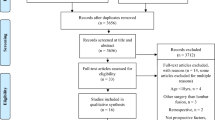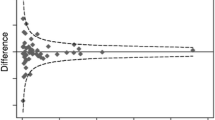Abstract
Purpose
Patient-reported outcome measures (PROMs) have become an important part of routine auditing of outcomes in spinal surgery in the UK. PROMs can be used to help assess the quality of care provided by surgical units by determining the comparative health status of patients, before and after surgery. This study was designed to review the PROMs used to assess outcomes in spinal surgery and to determine if they are fit for the purpose.
Methods
A systematic literature search was undertaken to identify studies that reported PROMs data following lumbar spinal surgery. The PROMs that were used in each study were recorded and a separate search was undertaken to determine the evidence regarding the validity of each measure.
Results
The initial search identified 1142 abstracts, which were reduced through de-duplication, filtering and review to 58 articles, which were retrieved and reviewed in full. The search identified that the majority of studies used either the Oswestry Disability Index (ODI), SF-36, Roland–Morris Disability Questionnaire (RMDQ) and EQ-5D along with visual analogue scales or numeric rating scales for back and leg pain.
Conclusions
The consistent use of PROMs supports the comparison of outcomes from different studies, although there was minimal evidence regarding the specificity and sensitivity of these measures for use with lumbar spinal patients. Our review highlights the need to determine a consensus regarding the use and reporting of outcome measures within the lumbar spine literature.

Similar content being viewed by others
References
NHS Commissioning D14 Complex Spinal Surgery (2014) http://www.england.nhs.uk/commissioning/spec-services/npc-crg/group-d/d14/. Accessed 22 Dec 2014
Schluessmann E, Diel P, Aghayev E et al (2009) On behalf of School of the SWISSspine Registry Group SWISSspine: a nationwide registry for health technology assessment of lumbar disc prostheses. Eur Spine J. 18:851–861
Röder C, Chavanne A, Mannion AF, Grob D, Aebi M (2005) SSE Spine tango—content, workflow, set-up. www.eurospine.org—Spine tango. Eur Spine J 14:920–924
British Spine Registry (2014) http://bsrcentre.org.uk/. Accessed 28 Nov 2014
The EuroQol Group (1990) EuroQol-a new facility for the measurement of health-related quality of life. Health Policy 16:199–208
Fairbank J, Pynsent P (2000) The Oswestry disability index. Spine 25:2940–2953
NHS Commissioning Board (2013). D14 Commissioning policy. http://www.england.nhs.uk/wp-content/uploads/2013/06/d14-comp-spinal-surg.pdf. Accessed 28 Nov 2014
Jenkinson C, Stewart-Brown S, Peterson S, Paice C (1999) Assessment of the SF-36 version 2 in the United Kingdom. J Epidemiol Commun Health 53:46–50
Grevitt M, Khazim R, Webb J, Mulholland R, Shepperd J (1997) The short form-36 health survey questionnaire in spine surgery. J Bone Jt Surgery 79(B(1)):48–52
Mueller B, Carreon LY, Glassman SD (2013) Comparison of the EuroQol-5D with the Oswestry Disability Index, back and leg pain scores in patients with degenerative lumbar spine pathology. Spine 38:757–761
Roland M, Morris R (1983) A study of the natural history of back pain. Part I: development of a reliable and sensitive measure of disability in low-back pain. Spine 8:141–144
Roland M, Fairbank J (2000) The Roland-Morris Disability Questionnaire and the Oswestry Disability Questionnaire. Spine 25:3115–3124
Zanoli G, Stromqvist B, Jonsson B (2001) Visual analog scales for interpretation of back and leg pain intensity in patients operated for degenerative lumbar spine disorders. Spine 26:2375–2380
Hawker GA, Mian S, Kendzerska T, French M (2011) Measures of adult pain. Arthritis Care Res 63:S240–S252
Fairbank J, Couper J, Davies J, O’Brien JP (1980) The Oswestry low back pain questionnaire. Physiotherapy 66:271–273
Beurskens A, deVet HCW, Koke AJA (1996) Responsiveness of functional status in low back pain: a comparison of different instruments. Pain 65:71–76
Fisher K, Johnson M (1997) Validation of the Oswestry low back pain disability questionnaire, its sensitivity as a measure of change following treatment and its relationship with other aspects of the chronic pain experience. Physiother Theory Pract 13:67–80
Kopec JA, Esdaile JM, Abrahamowicz M, Abenhaim L, Wood-Dauphinee S, Lamping DL et al (1996) The Quebec Back Pain Disability Scale: conceptualization and development. J Clin Epidemiol 49:151–161
Bergner M, Bobbitt RA, Carter WB et al (1981) The sickness impact profile: development and final revision of a health status measure. Med Care 19:787–805
Williamson A, Hoggart B (2005) Pain: a review of three commonly used pain rating scales. J Clin Nurs 14:798–804
Childs JD, Piva SR, Fritz J (2005) Responsiveness of the numeric pain rating scale in patients with low back pain. Spine 30:1331–1334
Deyo R, Battie M, Beurskens A, Bombardier C, Croft P, Koes B, Malmivaara A, Roland M, Korff M, Waddell G (1998) Outcome measures for low back pain research. A proposal for standardized use. Spine (Phila Pa 1976) 23:2003–2013
Mannion AF, Porchet F, Kleinstück FS, Lattig F, Jeszenszky D, Bartanusz V, Dvorak J, Grob D (2009) The quality of spine surgery from the patient’s perspective. Part 1: the Core Outcome Measures Index in clinical practice. Eur Spine J 18(Suppl 3):367–373
Mannion AF, Elfering A, Staerkle R, Junge A, Grob D, Semmer NK, Jacobshagen N, Dvorak J, Boos N (2005) Outcome assessment in low back pain: how low can you go? Eur Spine J 14:1014–1026
Stucki G, Daltroy LH, Liang MH, Lipson SJ, Fossel AH, Katz JN (1996) Measurement properties of a self-administered outcome measure in lumbar spinal stenosis. Spine 21:796–803
Pratt RK, Fairbank JC, Virr A (2002) The reliability of the Shuttle Walking Test, the Swiss Spinal Stenosis Questionnaire, the Oxford Spinal Stenosis Score, and the Oswestry Disability Index in the assessment of patients with lumbar spinal stenosis. Spine 27(1):84–91
Comer CM, Conaghan PG, Tennant A (2011) Internal construct validity of the Swiss Spine Stenosis Questionnaire: Rasch analysis of a disease-specific outcome measure for lumbar spinal stenosis. Spine (Phila Pa 1976) 36(23):1969–1976
Daltroy LH, Cats-Baril WL, Katz JN, Fossel AH, Liang MH (1996) The North American spine society lumbar spine outcome assessment instrument: reliability and validity tests. Spine 21(6):741–748
Sarasqueta C, Gabaldon O, Iza I, Béland F, Paz PM (2005) Cross-cultural adaptation and validation of the NASS outcomes instrument in Spanish patients with low back pain. Eur Spine J 14(6):586–594
Stoll T, Huber E, Bachmann S, Baumeler HR, Mariacher S, Rutz M, Schneider W, Spring H, Aeschlimann A, Stucki G, Steiner W (2004) Validity and sensitivity to change of the NASS questionnaire for patients with cervical spine disorders. Spine 29(24):2851–2855
Beyer F et al (2013) Percutaneous interspinous spacer versus open decompression: a 2-year follow-up of clinical outcome and quality of life. Eur Spine J 22(9):2015–2021
Kleinstueck FS et al (2012) To fuse or not to fuse in lumbar degenerative spondylolisthesis: do baseline symptoms help provide the answer? Eur Spine J 21(2):268–275
Kleinstueck FS et al (2011) The outcome of decompression surgery for lumbar herniated disc is influenced by the level of concomitant preoperative low back pain. Eur Spine J 20(7):1166–1173
Sobottke R et al (2010) Clinical outcomes and quality of life 1 year after open microsurgical decompression or implantation of an interspinous stand-alone spacer. Minim Invasive Neurosurg 53(4):179–183
Grob D et al (2010) A comparison of outcomes of cervical disc arthroplasty and fusion in everyday clinical practice: surgical and methodological aspects. Eur Spine J 19(2):297–306
Kleinstück FS et al (2009) The influence of preoperative back pain on the outcome of lumbar decompression surgery. Spine (Phila Pa 1976) 34(11):1198–1203
Rothman M, Burke L, Erickson P, Leidy NK, Patrick DL, Petrie CD (2009) Use of existing patient-reported outcome (PRO) instruments and their modification: the ISPOR good research practices for evaluating and documenting content validity for the use of existing instruments and their modification PRO task force report. Value Health 12:1075–1083
Stratford P, Binkley J (1997) Measurement properties of the RM-18: a modified version of the Roland–Morris Disability Scale. Spine 22:2416–2421
Patrick D, Deyo R, Atlas S et al (1995) Assessing health-related quality of life inpatients with sciatica. Spine 20:1899–1909
Underwood M, Barnett A, Vicker M (1999) Evaluation of two time-specific back pain outcome measures. Spine 24:1104–1112
Walsh TL, Hanscom B, Lurie JD, Weinstein JN (2003) Is a condition-specific instrument for patients with low back pain/leg symptoms really necessary? Spine 28:607–615
Garratt A, Moffett J, Farrin A (2001) Responsiveness of generic and specific measures of health outcome in low back pain. Spine 26:71–77
Rihn JA, Berven S, Allen T, Phillips FM, Currier BL, Glassman SD et al (2009) Defining value in spine care. Am J Med Qual 24:4S–14S
Hägg O, Fritzell P, Nordwall A (2003) The clinical importance of changes in outcome scores after treatment for chronic low back pain. Eur Spine J 12:12–20
Haefeli M, Elfering A, Aebi M, Freeman BJ, Fritzell P, Guimaraes Consciencia J et al (2008) What comprises a good outcome in spinal surgery? A preliminary survey among spine surgeons of the SSE and European spine patients. Eur Spine J 17:104–116
Godil SS, Parker SL, Zuckerman SL, Mendenhall SK, Glassman SD, McGirt MJ (2014) Accurately measuring the quality and effectiveness of lumbar surgery in registry efforts: determining the most valid and responsive instruments. Spine J. 14:2885–2891
Clement RC, Welander A, Stowell C, Cha TD, Chen JL, Davies M, Fairbank JC, Foley KT, Gehrchen M, Hagg O, Jacobs WC (2015) A proposed set of metrics for standardized outcome reporting in the management of low back pain. Acta orthopaedica. 86(5):523–533
Turk DC, Dworkin RH, Allen RR, Bellamy N, Brandenburg N, Carr DB, Cleeland C, Dionne R, Farrar JT, Galer BS, Hewitt DJ, Jadad AR, Katz NP, Kramer LD, Manning DC, McCormick CG, McDermott MP, McGrath P, Quessy S, Rappaport BA, Robinson JP, Royal MA, Simon L, Stauffer JW, Stein W, Tollett J, Witter J (2003) Core outcome domains for chronic pain clinical trials: IMMPACT recommendations. Pain 106:337–345
Author information
Authors and Affiliations
Corresponding author
Ethics declarations
Conflict of interest
None of the authors has any potential conflict of interest.
Rights and permissions
About this article
Cite this article
Stokes, O.M., Cole, A.A., Breakwell, L.M. et al. Do we have the right PROMs for measuring outcomes in lumbar spinal surgery?. Eur Spine J 26, 816–824 (2017). https://doi.org/10.1007/s00586-016-4938-x
Received:
Revised:
Accepted:
Published:
Issue Date:
DOI: https://doi.org/10.1007/s00586-016-4938-x




